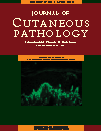Marked papillary dermal edema – an unreliable discriminator between polymorphous light eruption and lupus erythematosus or dermatomyositis
Abstract
Background: The clinical differential diagnosis of photo-distributed papules and plaques includes polymorphous light eruption (PMLE) and lupus erythematosus (LE). These entities share many histopathological features. However, in most contemporary textbooks, a broad band of papillary dermal edema is reported to be characteristic of PMLE and not seen in LE. Nonetheless, older reports describe papillary dermal edema in LE, including acute cutaneous LE (ACLE) in patients with systemic LE (SLE) and early lesions of discoid lupus erythematosus (DLE). Older reports also describe papillary dermal edema in microscopic sections of dermatomyositis (DM).
Methods: Retrospective review.
Results: Nine cases of LE (including two patients with acute lesions of SLE, six with DLE and one unclassifiable) and three cases of DM were identified in which sections showed striking papillary dermal edema. Attributes of chronicity, such as epidermal atrophy, follicular plugging and basement membrane thickening, were present concurrently in many sections.
Conclusions: Marked papillary dermal edema does not reliably distinguish PMLE from LE as it can be seen in ACLE, early and late lesions of DLE and DM. This phenomenon has been underemphasized in recent reports and textbooks. Furthermore, papillary dermal edema in chronic lesions of DLE has not been previously reported.
Pincus LB, LeBoit PE, Goddard DS, Cho RJ, McCalmont TH. Marked papillary dermal edema – an unreliable discriminator between polymorphous light eruption and lupus erythematosus or dermatomyositis.




